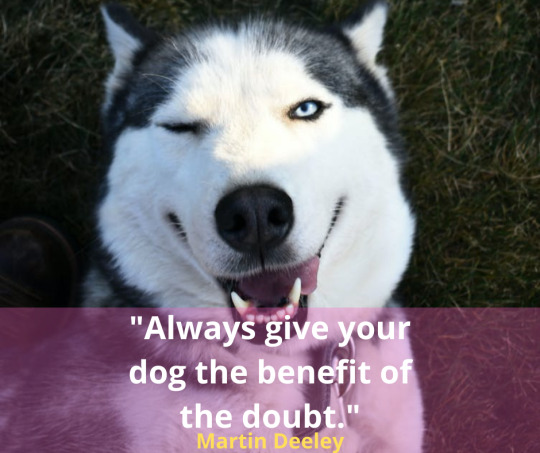Text
Understand How Your Dog Learns :-

Dogs learn a lot like little kids. They are close in intelligence to human two-year-olds. Immediate consequences are all that they care about. As they grow, they begin to understand our words. Some intelligent breeds will respond to as many as 250! Yet every dog responds to the tone of our voice more than the actual words.
There are three types of dog intelligence recognized by scientists:
1.Instinctive
2.Adaptive
3.Working and obedience
Instinctive learning is when your dog learns the behaviors they were bred. Adaptive learning is how well your dog learns from their surroundings and the environment around them to solve problems. Working and obedience are how well they learn the tasks and commands that you teach them.
To get your dog to be obedient, you should focus on training that uses obedience techniques and the specific behaviors you want from them. Both aversive- and reward-based training have been proven to
[Know more Unique Information BY CLICKING here ]
#dailydog#instapuppylove#dogsofinsta#cutedoggies 💕🐾💕💕💕 #dogsofinstagram#puppydaily#dogloversofig#puppyinstagram#mydogsthecutest#ilovemydog#puppyfun#dogloverclub#puppylife🐾#puppygram#puppyvideo#puppylove#doggiesofinstagram#dogsloversclub#doglover🐶#puppylove🐾#puppyworld#puppyloversofinstagram#puppyloves#dogselfies#cutedogsdaily#cutepuppies#instapuppys#dogloverstagram#dogloversofinstagram
1 note
·
View note
Text
Three reasons to train your puppyHow Should You Train Your Dog?
here are two common methods of training a dog.

The first is the aversive-based method. The second is the reward-based method. Aversive-based (discipline) training is when you use positive punishment and negative reinforcement techniques with your dog. Reward-based methods use rewards only for the behaviors that you want your dog to follow.
Aversion-based training uses techniques like loud, unpleasant noises, physical corrections, and harsh scoldings to get your dog to act the way you want. On the other hand, reward-based training uses rewards whenever your dog does something you want it to do. Treats, belly rubs, or other dog-pleasing actions are used to reinforce that a behavior was good.
'How to train your puppy' is for you who have a puppy and for you who have an adult dog !!!
You will get to know :---
1.Learn how to raise the perfect puppy.
2.Learn how to socialize and house train a new puppy.
3.Gain a fundamental understanding of the field of Learning Theory.
4.Learn how to measure the effectiveness of different behavior modification strategies.
5.Learn to train your dog to be a well-behaved canine companion.
6.Learn to train your dog to be reliably under control, off-leash, at a distance, around distractions.
7.Learn to phase out the use of food and other external rewards in training.
LEARN MORE INFORMATION TO ENRICH YOUR KNOWLEDGE
{ Inbox Me for Unique Information } !! 😀🦮
#doggiesofinstagram#dogsloversclub#dogselfies#dogloversofinstagram#dogsofinstagram#puppydaily#dogloversofig#puppygram#cutedoggies#cutedogsdaily#instapuppylove#puppyfun#puppyinstagram#mydogsthecutest#puppylife#dogloverstagram#puppyloves#dogloverclub#dogsofinsta#doglover#puppy#dailydog#cutepuppies#instapuppys#ilovemydog#puppyvideo#puppylove#puppyloversofinstagram ##dogloverforlife
0 notes
Text
How to Introduce Dogs

Have you ever seen dogs meet for the first time? A positive first meeting is no accident. Did you know there are ways owners can set their dogs up for successful social interaction? Keep reading to learn how to introduce dogs to new pets and people
Tips for socializing your dog
Tricks to get more friendly to your Dog:-
Dogs have unique personalities. Some are more social than others. But dogs can also be trained to get along with other dogs, animals and people. Socializing a dog works best when you:
Start young
Create a safe environment
Make socializing a priority
Watch for signs of stress or distress
Develop opportunities to try introductions
No matter what your dog's age, it's never too late to learn how to socialize your dog. Here are some ideas to try every day:
Play games with your dog like "fetch" to teach your dog body language and sharing.
Interact with other dogs to help your dog interact appropriately.
Observe your dog's emotional state. (Behaviors like cowering and tail-tucking indicate he's overwhelmed.)
Reward good behavior. Progress deserves praise your dog will recognize.
Puppy socialization
Just like children, puppies go through key developmental periods. Their brains are busy learning about the big world around them. So, starting young will help your puppy develop social skills for life. Purina Senior Scientist, Human/Animal Bond, Ragen McGowan explains, “the sensitive period for puppies begins at about 3 weeks of age and lasts until about 12 weeks of age.”
During this period, it is important to expose your puppy to a lot of new experiences. Some ideas on how to socialize a puppy include opportunities to:
Meet new people
Meet other dogs (and cats, too)
Visit new places
Get comfortable around children
LEARN MORE INFORMATION
To a puppy, children may just seem like small humans that make funny noises and unpredictable movements. That's why it's especially important to introduce your puppy to children during this period. That way your puppy will the learn the differences between children and adults.
How do new experiences help dog socialization?
Think about dog and puppy socialization this way – it’s practice. The more you and your dog practice, the more socialized he becomes. Each and every new experience will build on what your dog has already learned. Try to praise good behavior at every opportunity. Praise will not only reinforce good behavior, it sets up your dog up for lifelong success.
How to introduce dogs in your family
Already have a pet dog? Here are some ways you can welcome a new dog into the family:
Prevent tension. Meeting at a place that isn’t your house or yard can limit territorial behavior.
Be calm. Your dog can sense if you’re stressed – from your voice, body language and even if you’re holding his leash taut.
Give them space. Dogs will be more at ease if they can each retreat to a comfort zone.
Take it slow. You have a lot of time to help your dogs build a lasting relationship.
CLICK HERE TO LEARN MORE
#doggiesofinstagram#dogsloversclub#dogselfies#dogloversofinstagram#dogsofinstagram#puppydaily#dogloversofig#puppygram#cutedoggies#cutedogsdaily#instapuppylove#puppyfun#puppyinstagram#mydogsthecutest#puppylife#dogloverstagram#puppyloves#dogloverclub#dogsofinsta#doglover#puppy#dailydog#cutepuppies#instapuppys#ilovemydog#puppyvideo#puppylove#puppyloversofinstagram#dogloverforlife
1 note
·
View note